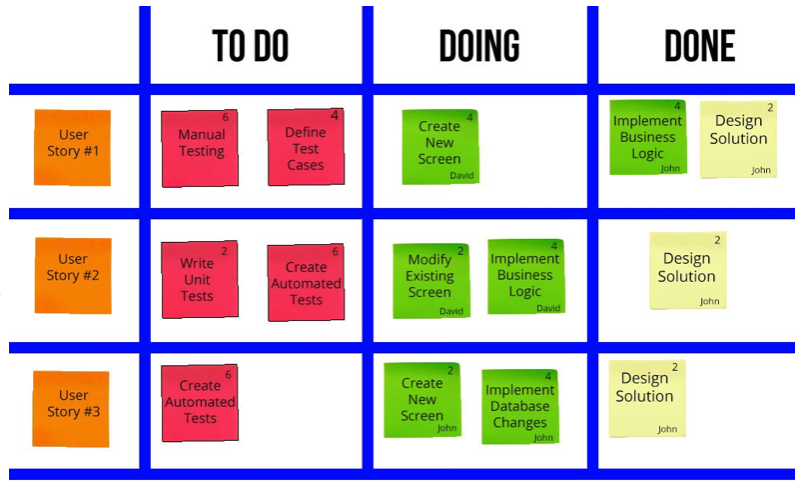Purpose Of The Daily Scrum Meeting
The Daily Scrum Meeting is for the TEAM to self-organize towards achieving their Sprint commitment.
Objectives
- Team Sync – The daily scrum is for the team to review progress toward their Sprint goal
- Assess Risks – The team assesses any risks to their Sprint commitment
- Adjust Plan – The team makes adjustments to their plan to meet the sprint commitment
- Full Team – It is important for all team members to attend
- Team Goal – Everyone needs to approach the Sprint as a team goal, not a set of individual goals
- Team Ownership – Each team member should own and share responsibility of the full sprint backlog
- Accountability – The team should hold each other accountable for achieving their daily commitments
Myths
| Myth | Correct Action |
| The meeting is a status meeting for management (or the ScrumMaster) | The ScrumMaster purely serves as a facilitator on behalf of the team. Status to folks outside the team can be a secondary benefit, but it is not the primary purpose. |
| You only have to attend the daily scrum if you accomplished something towards the Sprint goal | As a team member, it is still important for you to engage in what the rest of the team is doing. It is also important for the rest of the team to understand why you are struggling to make progress. |
| It is the ScrumMaster’s responsibility to monitor and adjust the plan | It is up to the team to own the plan and make any needed changes |
| Everyone provides status to the ScrumMaster | The team should provide status to each other |
| No one pays attention to each other’s status (focusing on individual goals) | The team should focus on the team goal |
| Only the ScrumMaster identifies risks and mitigations | The whole team has responsibility for identifying risks and developing mitigation strategies |
Tools

- Sprint Backlog – Allows the team to have visibility into all of the tasks remaining to achieve their sprint commitment
- Sprint Burndown Chart – Allows the team to quantify the amount of work remaining and if the team is on track
Key Metrics
- How many days are left in the Sprint? — This reinforces the urgency of a looming deadline
- How many points have been signed off by the Product Owner? — This reinforces that it only matters if we complete stories (not just getting to code complete)
- How many hours are remaining compared to our target plan? — This provides a view of how the team is progressing, most easily represented in a Sprint Burndown Chart.
Related Articles:

 Transitioning processes and cultures simultaneously is very difficult. A Successful Agile transition requires team ownership and engagement in developing the best process to fit your unique culture and environment. Five areas where team members are integral to push the process forward and become successful are outlined below.
Transitioning processes and cultures simultaneously is very difficult. A Successful Agile transition requires team ownership and engagement in developing the best process to fit your unique culture and environment. Five areas where team members are integral to push the process forward and become successful are outlined below. If Your Sprints are crazy, do any of these issues sound familiar?
If Your Sprints are crazy, do any of these issues sound familiar?


 For new teams, I try and encourage them to use a physical task board over tracking tasks in a tool. This can be problematic when all team members are not in the same location, but it has some huge advantages for co-located teams.
For new teams, I try and encourage them to use a physical task board over tracking tasks in a tool. This can be problematic when all team members are not in the same location, but it has some huge advantages for co-located teams. I get a little resistance from teams to start using Story Points for estimating, but it really is a superior way to estimate over hour based estimates.
I get a little resistance from teams to start using Story Points for estimating, but it really is a superior way to estimate over hour based estimates. “What do you think the impact will be on an organization of having a potentially shippable product increment at least every 30 days?”
“What do you think the impact will be on an organization of having a potentially shippable product increment at least every 30 days?” I believe Test-Driven Development is one of the key Agile practices that should be combined with Scrum in order to be highly productive. Scott Ambler’s recent article on
I believe Test-Driven Development is one of the key Agile practices that should be combined with Scrum in order to be highly productive. Scott Ambler’s recent article on  I think getting teams to be self-organizing in a productive way is one of the toughest challenges of Scrum.
I think getting teams to be self-organizing in a productive way is one of the toughest challenges of Scrum. I just read an article about how the Duke Nukem project went on for 12 years and never released.
I just read an article about how the Duke Nukem project went on for 12 years and never released.